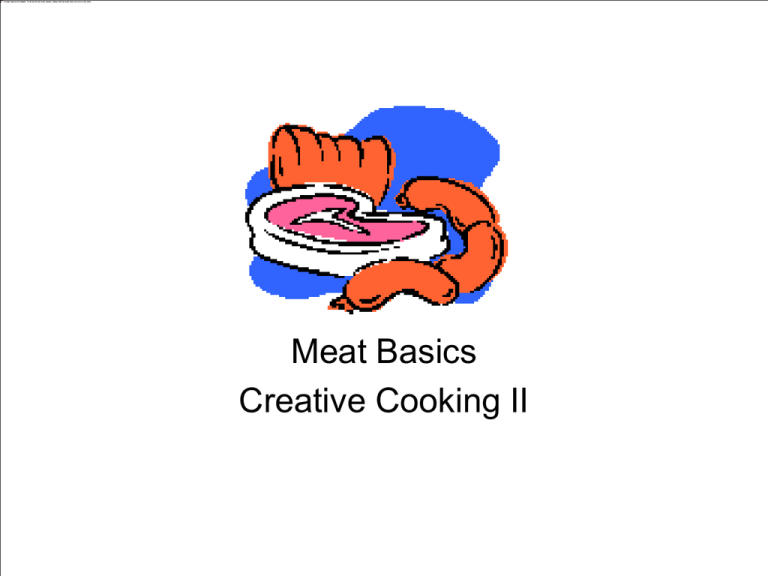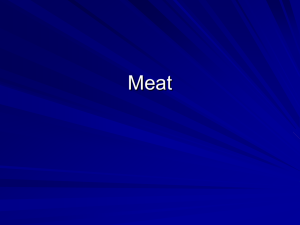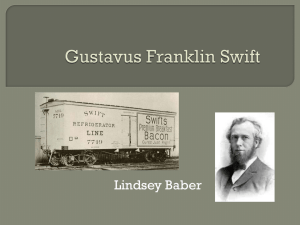Meat Basics Spring 11 - Hinsdale Central High School
advertisement

Meat Basics Creative Cooking II Nutritional Component of Meat • Water = 75% Protein = 20 % Fat= 5% • Shrinkage: Occurs when meat loses water as it cooks • Marbling: Fat within • muscle tissue Fat Cap: fat that surrounds muscle tissue Barding: Wrapping lean meat with fat Larding: Inserting fat or vegetables into lean meat Structure of Meat • Muscle Fibers: The smaller the muscle fibers are the more tender the meat • Connective Tissue: Connects muscles to bones; very tough. • Collagen: Soft white tissue that breaks down. Elastin: Hard yellow tissue that doesn’t break down. Bones: Older animals have whiter bones; younger animals have redder bones. Purchasing Forms • Primal Cuts: Also called wholesale cuts; easy to handle and divide • Fabricated Cuts: Menu-sized portions • Whole Carcass Menu Inspection & Grading Inspection: Mandatory USDA Stamp of Approval Quality Grade: Prime, Choice, Select. Yield Grades: Numbers 1-5 indicate the amount of useable meat on beef and lamb. Meat Handling & Storage • Fresh Meat: Should be stored in the refrigerator at 41 F or below • Frozen Meat: Should be stored in the freezer at 0 F or below. Cuts of Meat Pork • • • • Loin Shoulder Butt Spareribs/Belly Ham Lamb • Shoulder • Shank/Breast • Rack • Loin • Leg Veal • Shoulder • Shank/Breast • Rack • Loin • Leg Beef • Chuck • Brisket/Plate/Flank • Rib • Loin • Round Processing Meat • Curing: Preserving meat with salt, sugar, spices, flavoring, and nitrates • Smoking: Exposing meat to the smoke of fragrant hardwoods such as hickory. • Irradiation: Exposing meat to medium doses of radiation to delay spoilage. Tenderness • The location of the muscle on the animal determines the tenderness of the meat. • If it is an area that receives little or no exercise then it will be a tender cut. – Rib – Loin • If the muscle is from an area that receives more exercise then it will be a less tender cut of meat. – Leg – Shoulder Principles of Cooking Meat DRY HEAT MOIST HEAT Dry-Heat Cooking • Used for Tender Cuts. – Warning: It can toughen and dry out meat over extended periods of time. – Examples: • Steaks • Rib Roasts Moist-Heat Cooking • Used for large, less tender cuts. – Warning: pay close attention to how much fat is in the cut of meat. Adding too much additional fat can make the final product greasy. – Examples: • Brisket • Chuck Roasts Determining Doneness • • • • • • Cooking Method Type of meat Internal temperature Color of the meat Size of the piece Amount of time cooked Taking Internal Temperature • Insert the thermometer at an angle, into the thickest part of the meat. • Avoid taking the temperature in fatty areas. • Avoid touching or getting near bone. • Meat is done when it reaches its proper internal temperature for at least 15 seconds. Color of Cooked Meat • Rare: Browned on the surface, with a red center; A thin outer layer of cooked meat appears gray. • Medium Rare: Browned on the surface with a thicker outer layer of gray. • Medium: Browned on the surface with an even thicker outer layer of gray and a pink center. • Medium-Well: Browned on the surface with a thick outer layer of gray and a center that is barely pink. • Well-Done: Browned on the surface and gray on the inside. Roasting Meats Hot, dry air is used to cook food. -Do not add liquids or cover the meat during cooking. -Baste meat in natural juices or a seasoned stock - Place meat fat side up when cooking it. Barding Meat • Wrapping meat with fat prior to cooking; Tie it with twine; Remove fat and twine a few minutes before meat is done to allow browning. Seasoning Roasted Meats • Trim heavy fat coverings down to a thin layer. • Season meat several hours prior to roasting. • Season meat again after it is done. • Season the meat’s juices and serve with the meat. • Sauces and Gravies: Deglaze the pan and combine the drippings with a thickening agent and a demi glace Broiling & Grilling Meats • The shorter the cooking time, the higher the heat needed. • The thicker the cut, the longer the cooking time needed. • Vary the cooking temperature by moving the meat to different areas of the grill. • When grilling red meats, make sure the heat is high enough to brown the surface. Sautéing & Pan-Frying Meats Heat the pan before adding the fat Use the correct amount of fat Never overcrowd the pan. Turn or move the meat as little as possible. Braising & Stewing Meats Pat the meat dry prior to browning, especially if it has been marinated. Dredge the meat in flour just before cooking to improve browning. Do not use more liquid than is necessary. When meat is done, it should be fork tender. Make Lean & Variety of Choices Meat & Beans 5 oz. Recipes for meat lab Beef & Pepper Stir Fry Grilled Beef Kabobs Steak Burritos Glazed Ham Slice Southern BBQ Pork Chops Pork Tenderloin Roast







